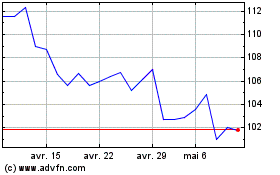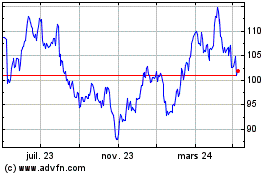By William Boston
When Bertha Benz, wife and business partner of German inventor
Karl Benz, took the first long-distance ride in an automobile, her
husband's newly patented motorcar, one August day in 1888, it was
little more than a horse-drawn carriage with an engine.
That has been mostly the case for the past 132 years. It's about
to change.
The space inside the car that is designed for its operator and
passengers is built around the mechanical requirements of the car's
engine, transmission and other components. The seating still
resembles a coach, though more comfortable, and the engine is more
powerful.
"Over the last 100 years you can't really say the car was
designed around the people; they got what space was left over,"
says Adrian van Hooydonk, 56, the chief designer for Bayerische
Motoren Werke AG.
As the auto industry contemplates the impact of technology --
from electric cars, internet connectivity, and ultimately vehicles
that drive themselves -- designers are reinventing the interior of
the automobile and how its passengers experience the ride. One
doesn't have to imagine some fantastic future with Jetsons-like
inventions zipping around on the ground and in the air because the
future is already on the drawing boards of car makers today.
And while it is too soon to say how the Covid-19 pandemic will
affect car interiors in the future, designers think there is more
emphasis now on cars as a safe space.
Last month, Hyundai Motors took the wraps off its latest concept
car, simply dubbed 45, an all-electric vehicle with swivel front
seats. The doors slide open to reveal a spacious interior with
clean, simple lines.
"It's all about the soothing, relaxing environment just for
you," SangYup Lee, design chief for Hyundai Motors, says in a video
presentation of the new 45 concept vehicle, describing the calming
effect of the lemon-colored light that illuminates the interior
"almost as if you're sitting in a Jacuzzi."
A concept car is a prototype, an actual car built to show off
what the industry can do and where it thinks the future of its
vehicles is headed. While the exact concept may not be built, the
technology will eventually be integrated into cars designed for
series production.
Some of the features of the 45, such as more comfortable seats
that recline and swivel, could be in models two to three years from
now. With more electric cars on the road, such features become
important to provide comfort for drivers and passengers enduring
long charging times.
Designs that completely transform the car's interior into a
working or relaxing space can only be realized once fully
autonomous vehicles are on the road. Cars with retractable steering
wheels, or seats that swivel so the driver can face the other
passengers while the car's robot drives are on the drawing board
today, but not possible yet. The self-driving hype of the past few
years has given way to the sober reality that it will take longer
to develop and deploy. And the coronavirus pandemic has put some of
the investment by auto makers on hold.
"Autonomous vehicles are going to be the real game-changer that
will bring new ways of using the cars and new business models,"
says Frank Rinderknecht, 64, founder and CEO of Rinspeed Inc., a
Swiss designer of concept vehicles and automotive consulting
firm.
Rinspeed has developed a series of prototypes dubbed Oasis to
demonstrate a new idea about modular design that can be applied to
a range of vehicles. Rinspeed describes the Oasis concept, first
presented at car shows a few years ago, as a "sanctuary on wheels."
It includes a lounge atmosphere, with seats that swivel so
passengers can face each other when the car's autonomous driver
takes the wheel.
"Oasis will only happen when we have autonomous vehicles," says
Mr. Rinderknecht. "It's going to be five or 10 years before we see
any implementation of self-driving cars."
Mr. van Hooydonk says BMW is thinking beyond the dashboard, to
when the windows become the display, even more so than today's
"head-up" display, in which dashboard information such as speed,
mileage or the charge left on the electric car's battery is
projected onto the windshield at eye level, allowing the driver to
see it without taking his or her eyes off the road.
"If you draw the analogy between the car interior and your
living room, you may want digital art. If the car becomes so
intelligent that it drives autonomously you have time for other
things," he says.
Behind such concepts is the belief that the car will become what
the industry calls a "third space," a link between the time spent
in the office and at home, a place where people will be able in the
future to use the same digital services in the car that they now
use at home. For designers, it means creating a space inside the
car that enhances that experience.
"When you get rid of dials and use head-up display you can do a
lot with that space. But it's when you get rid of the steering
column that things really open up," says Lisa Reeves, 39, Volvo
Cars director of interior program design.
Volvo, the Swedish car maker owned by China's Zhejiang Geely
Holding Group, is developing a model that could be tailored to
drivers' needs, just as trucks and delivery vans are today.
Ms. Reeves said when the company began thinking about designing
self-driving cars, they developed a concept car called the 360c,
which has four specific layouts: the office, the living room, the
party car and the sleeping car.
"It was a really cool concept," says Ms. Reeves. "You ordered a
room when you configured the car on your device. It really allows a
person to have their own space."
Today, Volvo is building cars for Uber Technologies Inc. that
the ride-hailing service can adapt with its own software and
features. Volvo also had this business model in mind when
developing its 360c project.
The office car would have an interactive table that
automatically links the car's computer to your smartphone when the
phone is placed on the table.
Volvo's sleeping car concept is more reminiscent of a
first-class airplane cabin than a motor-powered buggy that Bertha
Benz drove or even a Mercedes-Benz S-Class today. A comfortable
lounge setting, the interior can be converted into a sleeping car
for a long commute or shuttle to a distant meeting.
"With the sleeping car the idea was to rival domestic air
travel," says Ms. Reeves. "It would pick you up at your door and
was designed around ride-hailing concepts."
Even before the pandemic, the horizon for fully self-driving
cars on public highways in the hands of ordinary drivers had been
pushed out. The global economic toll from the coronavirus has
forced many industries to retrench, and may mean that car makers
will prioritize cost-cutting over near-term development of windows
as art installations.
That said, Covid-19 may reorder which advances come first. Smart
surfaces, with materials that would replace the dials and buttons
on the dashboard as input devices, could be self-cleaning. Such a
function could be essential for car-sharing and ride-hailing
vehicles used by many people.
Eva Garcia Lecina, director of surface engineering research at
Cidetec, a research institute in San Sebastian, Spain, says in the
future surfaces in car interiors will become more intelligent.
Cidetec is working on coatings that contain sensors to create
digitized surfaces that can send information to the vehicle's
computer to inform it to take action, to set off an alarm if there
is a security issue or to alert the car of a malfunction or change
of the environment.
Car makers are keen to use smart coatings that repel
fingerprints on display screens, or repel dyes that can stain
expensive interiors. Another area of research is into self-healing
surfaces -- like the robot in the Terminator movie that can heal
itself and change shape.
"All these new functionalities in the car are very nice, but if
they can repair themselves that really adds value," Ms. Garcia
says.
Write to William Boston at william.boston@wsj.com
(END) Dow Jones Newswires
July 17, 2020 11:15 ET (15:15 GMT)
Copyright (c) 2020 Dow Jones & Company, Inc.
Bayerische Motoren Werke (TG:BMW)
Graphique Historique de l'Action
De Mar 2024 à Avr 2024

Bayerische Motoren Werke (TG:BMW)
Graphique Historique de l'Action
De Avr 2023 à Avr 2024
